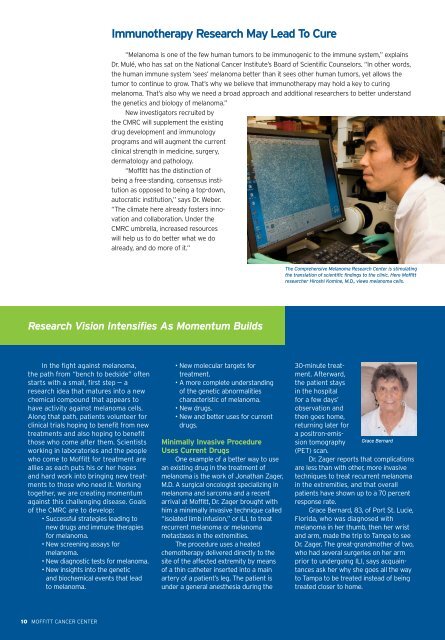Annual Report 2007 3-24-08.pdf - Moffitt Cancer Center
Annual Report 2007 3-24-08.pdf - Moffitt Cancer Center
Annual Report 2007 3-24-08.pdf - Moffitt Cancer Center
You also want an ePaper? Increase the reach of your titles
YUMPU automatically turns print PDFs into web optimized ePapers that Google loves.
Immunotherapy Research May Lead To Cure<br />
“Melanoma is one of the few human tumors to be immunogenic to the immune system,” explains<br />
Dr. Mulé, who has sat on the National <strong>Cancer</strong> Institute’s Board of Scientific Counselors. “In other words,<br />
the human immune system ‘sees’ melanoma better than it sees other human tumors, yet allows the<br />
tumor to continue to grow. That’s why we believe that immunotherapy may hold a key to curing<br />
melanoma. That’s also why we need a broad approach and additional researchers to better understand<br />
the genetics and biology of melanoma.”<br />
New investigators recruited by<br />
the CMRC will supplement the existing<br />
drug development and immunology<br />
programs and will augment the current<br />
clinical strength in medicine, surgery,<br />
dermatology and pathology.<br />
“<strong>Moffitt</strong> has the distinction of<br />
being a free-standing, consensus institution<br />
as opposed to being a top-down,<br />
autocratic institution,” says Dr. Weber.<br />
“The climate here already fosters innovation<br />
and collaboration. Under the<br />
CMRC umbrella, increased resources<br />
will help us to do better what we do<br />
already, and do more of it.”<br />
The Comprehensive Melanoma Research <strong>Center</strong> is stimulating<br />
the translation of scientific findings to the clinic. Here <strong>Moffitt</strong><br />
researcher Hiroshi Komine, M.D., views melanoma cells.<br />
Research Vision Intensifies As Momentum Builds<br />
In the fight against melanoma,<br />
the path from “bench to bedside” often<br />
starts with a small, first step –– a<br />
research idea that matures into a new<br />
chemical compound that appears to<br />
have activity against melanoma cells.<br />
Along that path, patients volunteer for<br />
clinical trials hoping to benefit from new<br />
treatments and also hoping to benefit<br />
those who come after them. Scientists<br />
working in laboratories and the people<br />
who come to <strong>Moffitt</strong> for treatment are<br />
allies as each puts his or her hopes<br />
and hard work into bringing new treatments<br />
to those who need it. Working<br />
together, we are creating momentum<br />
against this challenging disease. Goals<br />
of the CMRC are to develop:<br />
• Successful strategies leading to<br />
new drugs and immune therapies<br />
for melanoma.<br />
• New screening assays for<br />
melanoma.<br />
• New diagnostic tests for melanoma.<br />
• New insights into the genetic<br />
and biochemical events that lead<br />
to melanoma.<br />
• New molecular targets for<br />
treatment.<br />
• A more complete understanding<br />
of the genetic abnormalities<br />
characteristic of melanoma.<br />
• New drugs.<br />
• New and better uses for current<br />
drugs.<br />
Minimally Invasive Procedure<br />
Uses Current Drugs<br />
One example of a better way to use<br />
an existing drug in the treatment of<br />
melanoma is the work of Jonathan Zager,<br />
M.D. A surgical oncologist specializing in<br />
melanoma and sarcoma and a recent<br />
arrival at <strong>Moffitt</strong>, Dr. Zager brought with<br />
him a minimally invasive technique called<br />
“isolated limb infusion,” or ILI, to treat<br />
recurrent melanoma or melanoma<br />
metastases in the extremities.<br />
The procedure uses a heated<br />
chemotherapy delivered directly to the<br />
site of the affected extremity by means<br />
of a thin catheter inserted into a main<br />
artery of a patient’s leg. The patient is<br />
under a general anesthesia during the<br />
30-minute treatment.<br />
Afterward,<br />
the patient stays<br />
in the hospital<br />
for a few days’<br />
observation and<br />
then goes home,<br />
returning later for<br />
a positron-emission<br />
tomography Grace Bernard<br />
(PET) scan.<br />
Dr. Zager reports that complications<br />
are less than with other, more invasive<br />
techniques to treat recurrent melanoma<br />
in the extremities, and that overall<br />
patients have shown up to a 70 percent<br />
response rate.<br />
Grace Bernard, 83, of Port St. Lucie,<br />
Florida, who was diagnosed with<br />
melanoma in her thumb, then her wrist<br />
and arm, made the trip to Tampa to see<br />
Dr. Zager. The great-grandmother of two,<br />
who had several surgeries on her arm<br />
prior to undergoing ILI, says acquaintances<br />
ask her why she goes all the way<br />
to Tampa to be treated instead of being<br />
treated closer to home.<br />
10 MOFFITT CANCER CENTER








